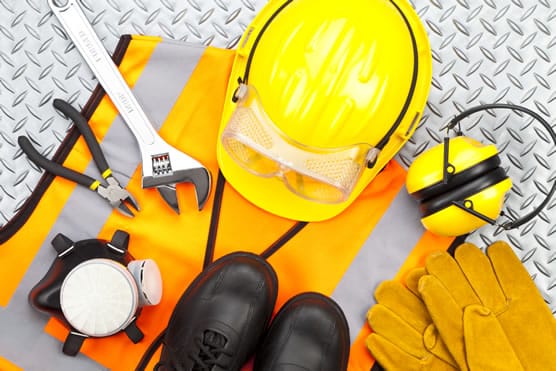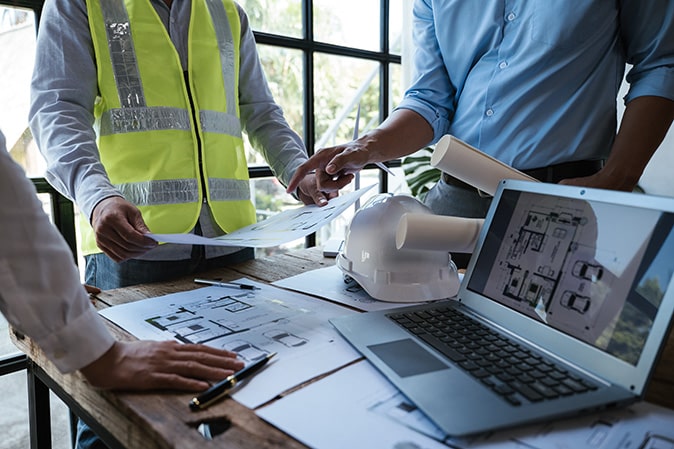Health & Safety is a fiendishly complicated area and your exact responsibilities as a self-builder will largely depend on how you choose to manage your project.
Duties applicable to a self-build site can be divided into necessary documentation and practical measures.
Documentation
Remember that the overarching aim of these regulations is to keep everyone safe on site, without imposing any additions burdens on builders. There are standard scenarios that most projects fall within:
The DIY project: The self-builder does it all himself, employing no contractors, and what is built is used as a home to live in. There is no requirement to adhere to most of the H&S safety regulations although you should ensure things like site is safe and secure at all times.
Appointing an external project manager: This could be a specialist person or an architect or designer. If it is an architect they may be assigned as Project Supervisors for the Design Stage. Whoever you choose may also be appointed as Principal Contractor (NI) / Project Supervisor for the Construction Stage (ROI), for the purpose of coordinating the construction phase, if that person or business has the skills, experience and knowledge to do the job. In this case the self-builder has no legal duties beyond the appointment of Project Supervisor for the Design Stage and Principal Contractor.
Employing a builder: As the contractor for the construction work for the duration of the project, they have the responsibility of hiring in any external sub-contractors required. The emphasis will be on the co-ordination and management of the construction phase. In this case the self-builder again has no legal duties beyond the initial appointments of Project Supervisor for the Design Stage and appointment of the Primary Contractor/Project Supervisor for the Construction Stage.
Project managing the build directly (direct labour): In this scenario the self-builder will be employing individual trades at different times and will be stepping out of the DIY arena, because they are taking control of construction work. The expectation on a self-builder in a Project Management position will be primarily on co-ordination and management, not on direct supervision of contractors on site. The self-builder is entitled to expect contractors to plan, manage and monitor their own work in compliance with the regulations. However, be aware that if you employ someone and control the way in which they carry out the work then the person will be considered a worker and you will take on the responsibility of an employer with all the insurance, supervision and H&S requirements that this entails.
They key documents are:
- Notification to authorities: HSENI in NI on the NI10 form / HSA in ROI on form AF1 sent by registered post or email
- A Construction Phase Health and Safety Plan for the site
- Method Statements and Risk Assessments for the site-specific activities
- A Construction Phase Site Fire Plan/Emergency Plan
- Traffic Management Plan
- Site Waste Management Plan
Practical measures
In terms of site security, robust methods need to be employed and clear signage to warn against entry and stipulate the site requirement regarding protective personal equipment (PPE).
The mandatory and minimum requirement for all construction sites is that all persons on site wear hi visibility clothing, a hard hat (dependent on risk level, if level is low, then a bump cap), safety footwear (steel toe caps and mid-sole protection).
A main site sign should be visible at the entrance to inform of the construction works, the PC details and contact, warning information and PPE requirements.
Welfare facilities You must make sufficient welfare provision such as providing an area to site and eat, the ability to warm food and boil water i.e. provide a microwave and kettle. The area must be dry and warm (provide a portable heater). A room or area must be available to change wet clothing and dry out wet clothing. A toilet must be provided with running water (warm and cold), soap and a means of drying your hands, this can be a chemical toilet.
First Aid Provision must be made for any minor incidents or accidents that may occur on site. A suitably sized First Aid Box must be available, the location should have clear signage. A trained first aider must be on site at all times when the site is open, preferably more than one person. The name of this person and contact number should be displayed.
Fire Safety Every site must have adequate fire protection, generally a CO2 and a water extinguisher will provide good cover. In the event of an emergency there must be a co-ordinated plan for all those working on site, others affected by the works and the emergency services. The Construction Phase Site Fire Plan will set out the evacuation procedure, and assembly point. An Assembly Point must be established and signage placed at this point. Adequate fire safety signage is required showing exit points, assembly point, where the extinguishers are and what type they are, who is on control in the event of an emergency; ‘responsible person’ being the site supervisor and a deputy appointed. An illustration of the evacuation plan should be displayed in the site accommodation.
Site waste Any skip on site must be provided by a licenced waste company. The skip should be secured with Heras fencing to prevent unwanted entry to the area. The skip should not be left open to the public at any time. Timbers placed in the skip should be de-nailed. The skip and all waste should be suitably segregated for recycling purposes. Waste transfer notes are required for all loads taken from site.
Dust A significant amount of dust is being generated by the site activities. Control measures must be applied such as the use of dust suppression attachments to cutting equipment, a mobile extraction system used, damping down and damp brushing. PPE such as dust masks should be worn but only after the previous measures have been applied and as a backup.
PAT testing Portable appliances used on site must have a valid PAT sticker to ensure they have been tested and reduce fire risk.
NI specific
In NI there must be an appointed and suitably trained site supervisor on site at all times. This person will have full responsibility for the site when it is active and everyone is on it. All site operatives must hold appropriate and valid CSR cards and plant tickets as relevant to their work. There are a number of mandatory things to be displayed on a site:
- the HSENI Law Poster – responsibilities for H&S
- the company insurance – valid employers and public liability
- a copy of the company H&S Policy Statement
- the emergency evacuation plan and emergency contacts recommended also ‘Site Rules’.
There should be health and safety documents held in a Site Safety File such as the CPHSP, RAMS, Fire Plan and emergency Procedures, Asbestos Report, Statutory approvals. It is useful to establish a second Site Safety File as a ‘working File’ and this should contain things like the daily Sign In/out sheet, regular inspection forms for plant, equipment, PPE, Permits to Work for digging, hot works etc
All operatives must have completed a site induction and a signed form be held in the site file. Induction should be available for visitors (single page information about the most obvious dangers on site). All visitors to site should be accompanied and have or be provided with appropriate PPE.
All ladders and stepladders, trestles and hop ups should be regularly inspected for use and this recorded on an inspection form. Long ladders used on scaffolding must be tied at two points (observed). Scaffolding must only be erected, altered and dismantled by a competent person. A handover certificate should be provided for initial scaffold set up, it should be inspected weekly and have a valid scaff tag attached.
ROI specific
If you need to appoint project supervisors, then the Project Supervisor Design Process (PSDP) must prepare a safety file. This file should contain the information needed to safely maintain the building and/or structure and have the information needed to carryout future work on the building or structure
The PSCS must develop and update the Construction Stage Safety and Health Plan and coordinate the implementation of the Construction Regulations. They will coordinate the checking of safe work procedures and monitor compliance, including ensuring workers have SafePass and relevant CSCS
cards. They must report accidents or near misses to the HSA. Similar to the NI tasks above, scaffolding and other equipment needs to be erected by a qualified scaffolder, and the erection accredited.
The HSA BeSMART.ie website offers site specific guidance for each construction risk; when using or reaching each stage, consult with the website to ensure all steps have been taken for the safe operation of the site. The Hazard Panel for General Builder includes:
- Fire
- Manual Handling
- Chemicals
- Display Screen Equipment
- Electricity on Site
- Slips, Trips & Falls on Site
- Angle Grinder
- Articulated Dumper
- Asbestos Containing Materials
- Attic Insulation (Blown Fibre)
- Attic Insulation (Rigid / Quilt)
- Bench Circular Saw
- Bitumen Boiler
- Building / Repairing Walls
- Building Surveying
- Cartridge Operated Tools
- Cement Mixer
- Compressed Air Tools
- Concrete Poker / Vibrator
- Concrete Pump (Boom/Static)
- Concrete Saw
- Confined Space
- Construction Dust
- Construction Site Traffic
- Demolition (Non-Explosive)
- Drone / SUA Operations
- Excavations
- Excavator 180 (Backhoe Loader)
- Excavator 360 (Tracked & Wheeled)
- External Wall Insulation
- Falling from a Vehicle
- Flat / Sloped Roofs
- Formwork / Falsework
- Fragile Roofs
- Gas Blow Torch
- Gas Cylinders
- Hand-Held Circular Saw
- Handling Window Glazing / Door Units
- Hot Works
- Industrial Vacuum
- Knapsack Sprayer
- Knives and Sharp Objects
- Ladder (Straight /Extension)
- Land Surveying and Setting Out
- Lifting Operations
- Loading / Unloading
- Lock Out / Tag Out
- Lone Working
- Manually Operated Hand Tools
- Metal Chop Saw
- Mini-Digger
- Mitre / Chop Saw
- Mobile / Crawler Crane
- Mobile Elevating Work Platform (MEWP)
- Mobile Generator
- Mobile Tower Scaffold
- Night and Shift Work
- Noise
- Objects Falling from a Vehicle
- Office Equipment
- Openings & Edges
- Outdoor Work
- Overhead Electricity Lines
- Personal Fall-Protection Equipment
- Piling Operations
- Planer
- Podium Steps
- Power Hand Tools
- Power Washer
- Pumped Cavity Wall Insulation
- Ride-on Roller
- Road Plate / Jumping Jack
- Road Saw
- Roll Forming Machine
- Roof and Wall Cladding
- Roof Ladders / Crawling Boards
- Safety Nets & Soft Landing Systems
- Sander
- Scaffold Erection, Modification & Dismantling
- Self-Erecting Tower Crane (SETC)
- Site Deliveries / Collections
- Site Dumper
- Site Security
- Skid Steer
- Spray Polyurethane Foam Insulation (SPFI)
- Stepladders (A-Frame)
- Stilts
- Stove, Fire and Fireplace Installation
- Structural Steelwork
- Telescopic Handler (Teleporter)
- Tower Crane
- Tractor
- Tractor / Dozer
- Tractor-Mounted / Trailed Machinery
- Trailer
- Underground Services
- Use of Scaffolding
- Van Loading / Unloading
- Vehicle / Plant Maintenance & Repairs
- Vehicle Overturning
- Vermin
- Vibration
- Visiting Construction Sites
- Welding
- Wet Hand Work
- Wood Dust
- Working on Roads
- Working Over or Near Water




















